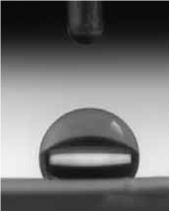
In general, when the contact angle formed by water droplets and the membrane material is less than 90 °, it means that the material is hydrophilic; if the contact angle is greater than 90 °, the material is hydrophobic, and the larger the contact angle, the more hydrophobic the material. If the contact angle is greater than 150°, the material is superhydrophobic. According to the Laplace-Young equation, the hydrophobic porous membrane of the medium through the membrane pore pressure and its own degree of hydrophobicity, membrane pore size and the surface tension of the medium are related.
PTFE material is the most hydrophobic material in the intrinsic properties of hydrophobic materials, due to its hydrophobic properties, under a certain pressure, due to the relationship between the surface tension of the water, the water medium can not penetrate the membrane pore, but is forced to isolate the surface of the membrane pore, while the membrane pore inside the membrane pore to maintain the anhydrous state, to provide a channel for the mass transfer process. Membrane absorption process must keep the membrane pore mass transfer channel dry and not be water infiltration, so the operating pressure of the membrane contactor must be kept under the tolerance pressure to maintain process stability.
Industrial water media composition is complex, the media surface tension is not the same, so the membrane contactor for different water quality has a different tolerance pressure. Routinely, different water environments need to be sampled and analyzed to determine the withstand pressure, the development of operating procedures for specific water environments.
System requirements: design piping resistance is as small as possible, the system height as low as possible, out of the water immediately emptied, out of the water valve is not allowed to close. If the system is operated incorrectly, serious overpressure, resulting in system operation failure, it is necessary to immediately stop, cleaning and blowing regeneration system, in order to restore the system's mass transfer performance.

